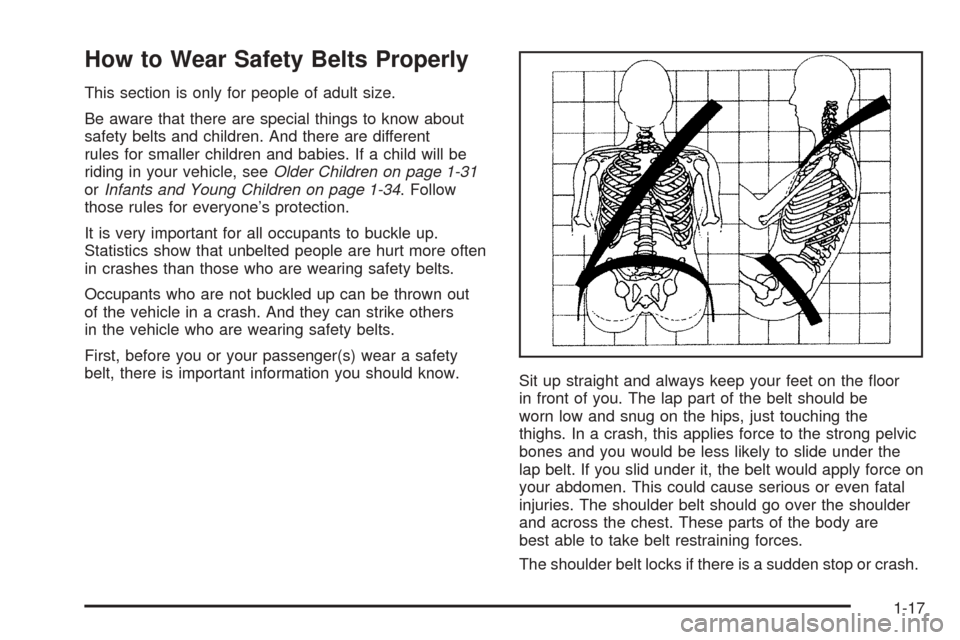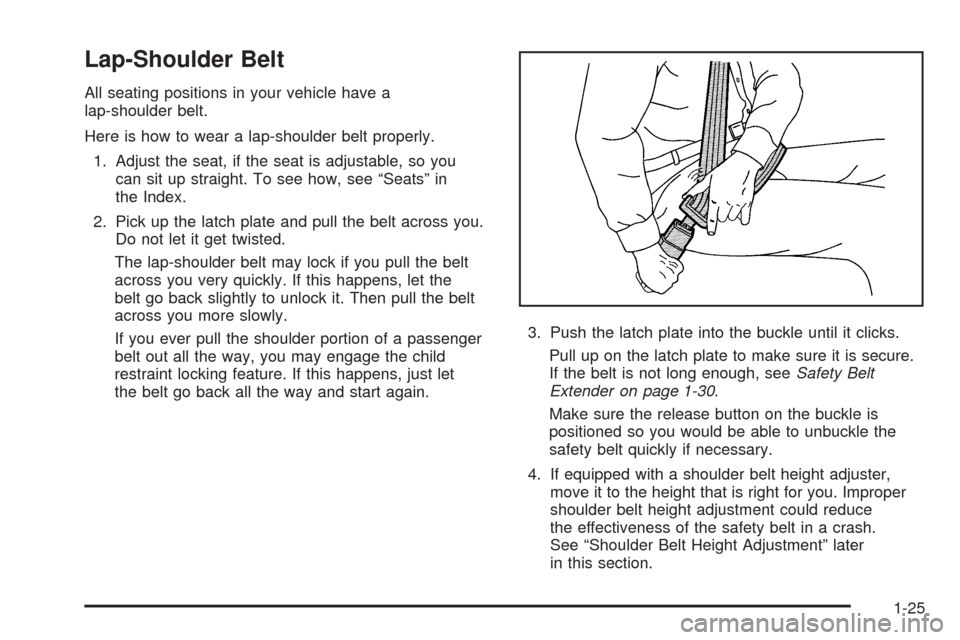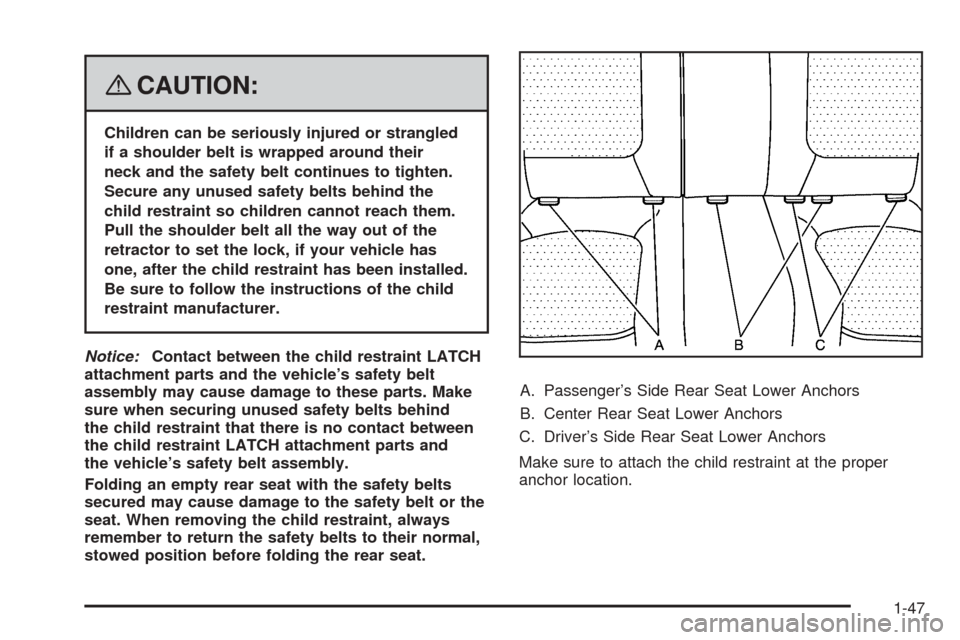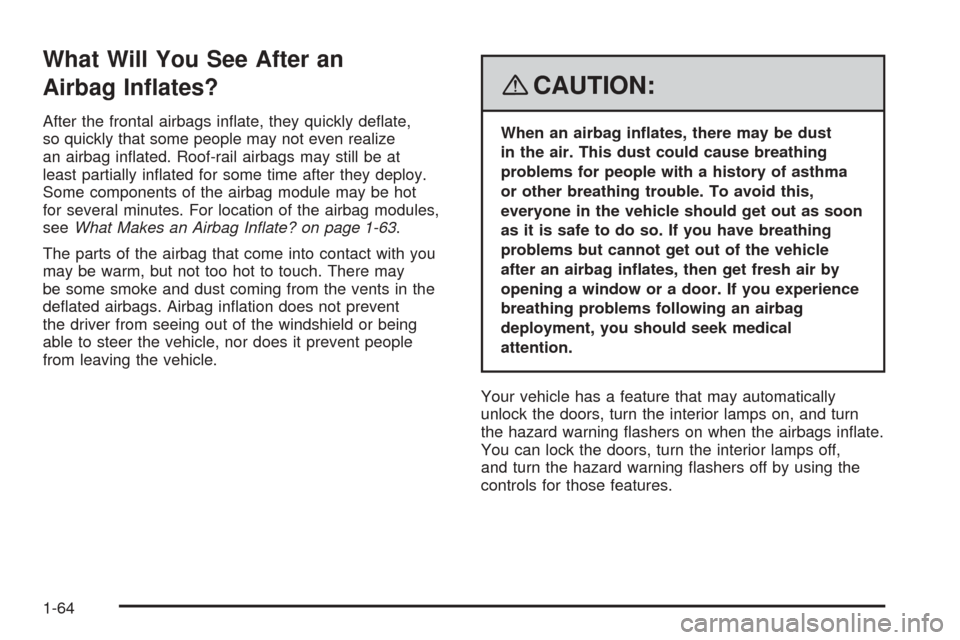Page 21 of 436

How to Wear Safety Belts Properly
This section is only for people of adult size.
Be aware that there are special things to know about
safety belts and children. And there are different
rules for smaller children and babies. If a child will be
riding in your vehicle, seeOlder Children on page 1-31
orInfants and Young Children on page 1-34. Follow
those rules for everyone’s protection.
It is very important for all occupants to buckle up.
Statistics show that unbelted people are hurt more often
in crashes than those who are wearing safety belts.
Occupants who are not buckled up can be thrown out
of the vehicle in a crash. And they can strike others
in the vehicle who are wearing safety belts.
First, before you or your passenger(s) wear a safety
belt, there is important information you should know.
Sit up straight and always keep your feet on the �oor
in front of you. The lap part of the belt should be
worn low and snug on the hips, just touching the
thighs. In a crash, this applies force to the strong pelvic
bones and you would be less likely to slide under the
lap belt. If you slid under it, the belt would apply force on
your abdomen. This could cause serious or even fatal
injuries. The shoulder belt should go over the shoulder
and across the chest. These parts of the body are
best able to take belt restraining forces.
The shoulder belt locks if there is a sudden stop or crash.
1-17
Page 29 of 436

Lap-Shoulder Belt
All seating positions in your vehicle have a
lap-shoulder belt.
Here is how to wear a lap-shoulder belt properly.
1. Adjust the seat, if the seat is adjustable, so you
can sit up straight. To see how, see “Seats” in
the Index.
2. Pick up the latch plate and pull the belt across you.
Do not let it get twisted.
The lap-shoulder belt may lock if you pull the belt
across you very quickly. If this happens, let the
belt go back slightly to unlock it. Then pull the belt
across you more slowly.
If you ever pull the shoulder portion of a passenger
belt out all the way, you may engage the child
restraint locking feature. If this happens, just let
the belt go back all the way and start again.3. Push the latch plate into the buckle until it clicks.
Pull up on the latch plate to make sure it is secure.
If the belt is not long enough, seeSafety Belt
Extender on page 1-30.
Make sure the release button on the buckle is
positioned so you would be able to unbuckle the
safety belt quickly if necessary.
4. If equipped with a shoulder belt height adjuster,
move it to the height that is right for you. Improper
shoulder belt height adjustment could reduce
the effectiveness of the safety belt in a crash.
See “Shoulder Belt Height Adjustment” later
in this section.
1-25
Page 31 of 436

Shoulder Belt Height Adjuster
Your vehicle has a shoulder belt height adjuster for
the driver and right front passenger.
Adjust the height so that the shoulder portion of the
belt is centered on your shoulder. The belt should
be away from your face and neck, but not falling off
your shoulder. Improper shoulder belt height adjustment
could reduce the effectiveness of the safety belt
in a crash.
To move it up or down,
squeeze the release
buttons (A) together and
move the height adjuster
to the desired position.
After you move the height adjuster to where you want it,
try to move it up or down without squeezing the release
buttons to make sure it has locked into position.
Safety Belt Pretensioners
Your vehicle has safety belt pretensioners for front
outboard occupants. Although you cannot see them,
they are part of the safety belt assembly. They can
help tighten the safety belts during the early stages of
a moderate to severe frontal and near frontal crash if
the threshold conditions for pretensioner activation
are met.
Pretensioners work only once. If they activate in a
crash, you will need to get new ones, and probably other
new parts for your safety belt system. SeeReplacing
Restraint System Parts After a Crash on page 1-73.
Rear Safety Belt Comfort Guides
Rear shoulder belt comfort guides may provide added
safety belt comfort for older children who have outgrown
booster seats and for some adults. When installed on
a shoulder belt, the comfort guide positions the belt
away from the neck and head.
1-27
Page 51 of 436

{CAUTION:
Children can be seriously injured or strangled
if a shoulder belt is wrapped around their
neck and the safety belt continues to tighten.
Secure any unused safety belts behind the
child restraint so children cannot reach them.
Pull the shoulder belt all the way out of the
retractor to set the lock, if your vehicle has
one, after the child restraint has been installed.
Be sure to follow the instructions of the child
restraint manufacturer.
Notice:Contact between the child restraint LATCH
attachment parts and the vehicle’s safety belt
assembly may cause damage to these parts. Make
sure when securing unused safety belts behind
the child restraint that there is no contact between
the child restraint LATCH attachment parts and
the vehicle’s safety belt assembly.
Folding an empty rear seat with the safety belts
secured may cause damage to the safety belt or the
seat. When removing the child restraint, always
remember to return the safety belts to their normal,
stowed position before folding the rear seat.A. Passenger’s Side Rear Seat Lower Anchors
B. Center Rear Seat Lower Anchors
C. Driver’s Side Rear Seat Lower Anchors
Make sure to attach the child restraint at the proper
anchor location.
1-47
Page 55 of 436
3. Push the latch plate into the buckle until it clicks.
Make sure the release button is positioned so you
would be able to unbuckle the safety belt quickly
if necessary.4. Pull the rest of the shoulder belt all the way out of
the retractor to set the lock.
1-51
Page 59 of 436
5. Pull the rest of the shoulder belt all the way out of
the retractor to set the lock.6. To tighten the belt, push down on the child restraint,
pull the shoulder portion of the belt to tighten
the lap portion of the belt and feed the shoulder
belt back into the retractor. If you are using a
forward-facing child restraint, you may �nd it
helpful to use your knee to push down on the
child restraint as you tighten the belt.
1-55
Page 65 of 436

{CAUTION:
If something is between an occupant and an
airbag, the airbag might not in�ate properly
or it might force the object into that person
causing severe injury or even death. The path
of an in�ating airbag must be kept clear.
Do not put anything between an occupant and
an airbag, and do not attach or put anything
on the steering wheel hub or on or near any
other airbag covering.
If your vehicle has roof-rail airbags, never
secure anything to the roof of your vehicle by
routing the rope or tie down through any door
or window opening. If you do, the path of an
in�ating roof-rail airbag will be blocked.
When Should an Airbag In�ate?
Frontal airbags are designed to in�ate in moderate to
severe frontal or near-frontal crashes to help reduce the
potential for severe injuries mainly to the driver’s or
right front passenger’s head and chest. However, they
are only designed to in�ate if the impact exceeds a
predetermined deployment threshold. Deployment
thresholds are used to predict how severe a crash
is likely to be in time for the airbags to in�ate and
help restrain the occupants.
Whether your frontal airbags will or should deploy
is not based on how fast your vehicle is traveling.
It depends largely on what you hit, the direction of the
impact, and how quickly your vehicle slows down.
1-61
Page 68 of 436

What Will You See After an
Airbag In�ates?
After the frontal airbags in�ate, they quickly de�ate,
so quickly that some people may not even realize
an airbag in�ated. Roof-rail airbags may still be at
least partially in�ated for some time after they deploy.
Some components of the airbag module may be hot
for several minutes. For location of the airbag modules,
seeWhat Makes an Airbag Inflate? on page 1-63.
The parts of the airbag that come into contact with you
may be warm, but not too hot to touch. There may
be some smoke and dust coming from the vents in the
de�ated airbags. Airbag in�ation does not prevent
the driver from seeing out of the windshield or being
able to steer the vehicle, nor does it prevent people
from leaving the vehicle.
{CAUTION:
When an airbag in�ates, there may be dust
in the air. This dust could cause breathing
problems for people with a history of asthma
or other breathing trouble. To avoid this,
everyone in the vehicle should get out as soon
as it is safe to do so. If you have breathing
problems but cannot get out of the vehicle
after an airbag in�ates, then get fresh air by
opening a window or a door. If you experience
breathing problems following an airbag
deployment, you should seek medical
attention.
Your vehicle has a feature that may automatically
unlock the doors, turn the interior lamps on, and turn
the hazard warning �ashers on when the airbags in�ate.
You can lock the doors, turn the interior lamps off,
and turn the hazard warning �ashers off by using the
controls for those features.
1-64